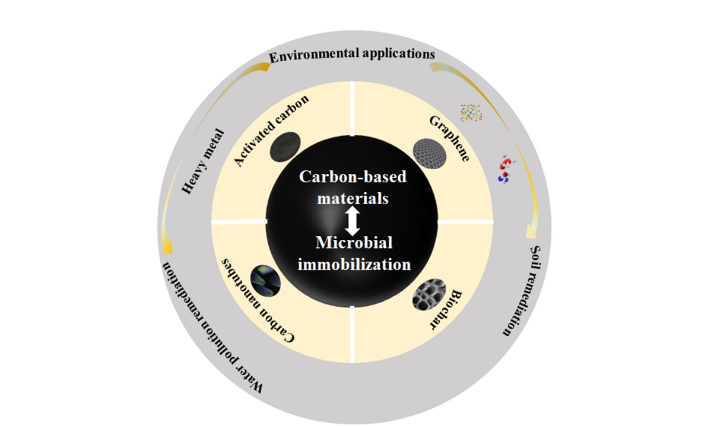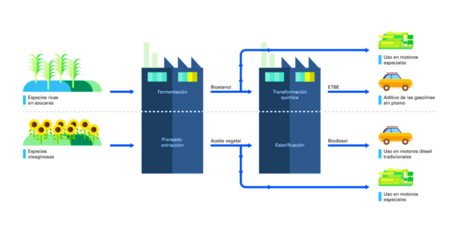
Laboratory technician
Bioengineering and Chemical Engineering Department
Environmental pollution caused by heavy metals, pesticides and persistent organic compounds has reached critical levels, driving the search for more efficient and sustainable technologies to remediate them. In this context, a recent study published in Water Emerging Contaminants & Nanoplastics explores the use of microorganisms immobilized in carbon-based materials as a promising solution for the decontamination of soils and waters affected by industrial waste.

Carbon-based materials: Platforms for bioremediation
Carbon-based materials such as biochar, graphene and carbon nanotubes have emerged as ideal platforms for the immobilization of microorganisms due to their porous structure, large surface area, chemical stability and high biocompatibility. These characteristics allow the microorganisms to maintain their metabolic activity and resistance to adverse environmental conditions, improving their ability to degrade a wide range of contaminants. According to Wang et al. (2024), immobilization of microorganisms in these materials improves the stability and efficiency of remediation processes while facilitating recovery and reuse of bioparticles once remediation is complete.
Applications in the Removal of Contaminants
Among the most studied materials, biochar has been shown to be particularly effective for the adsorption of heavy metals such as cadmium and nickel, as well as organic pollutants such as pesticides and polycyclic aromatic hydrocarbons (HAPs). The study highlights how the immobilization of Bacillus cereus in biochar allowed an efficient reduction of chromium (Cr VI) in contaminated soils, achieving a 94.22% conversion from Cr VI to Cr III, a less toxic state (Chen et al., 2021). Another example is the removal of pharmaceutical compounds such as erythromycin by using activated carbon loaded with specific microbial consortia, achieving 95% elimination efficiencies in aqueous solutions (Yang et al., 2023).
In addition to traditional materials such as biochar and activated carbon, carbon nanotubes and graphene are gaining prominence in this field. These nanomaterials have exceptional properties, such as high thermal and electrical conductivity, which can enhance the growth and metabolic activity of immobilised microorganisms. Although these materials are more expensive, their ability to adsorb complex toxic compounds and improve biodegradation rates makes them attractive candidates for applications in highly contaminated environments (Zhao et al., 2019; Perchikov et al., 2022).
Synergy between Microorganisms and Advanced Materials
One of the major advances in biotechnology applied to environmental remediation is the ability to combine the adsorbent properties of carbon-based materials with the degradative abilities of microorganisms. This synergistic approach has been successfully used in the removal of recalcitrant organic pollutants such as polychlorinated biphenyls (PCBs) and pesticides. For example, the use of biochar derived from agricultural waste has enhanced the growth of Pseudomonas hibiscicola in contaminated solutions, achieving removal efficiencies of up to 94% for heavy metals such as nickel and zinc (An et al., 2022).
Modified biochar has also shown a high capacity for immobilization and proliferation of micro-organisms capable of degrading aromatic hydrocarbons. Recent research highlights the effectiveness of this material in the remediation of soils and waters contaminated with oil, reaching rates of degradation of up to 45.52% for hydrocarbons in mixed soils (Li et al., 2022). This demonstrates the potential of using agricultural waste converted to biochar as a sustainable solution for decontaminating ecosystems affected by oil spills and other industrial wastes.
Challenges and future directions
Despite the great potential offered by carbon-based materials and immobilized microorganisms, significant challenges remain. One of the most important is the operational difficulty involved in producing and scaling these materials for industrial implementation. In addition, the high costs of advanced materials such as graphene and carbon nanotubes limit their large-scale use. However, progress in more accessible production techniques and the use of waste as a precursor to biochar could mitigate these problems.
Another crucial area of research is to improve the physical and chemical properties of carbon materials to enhance their interaction with microorganisms and maximize remediation effectiveness. For example, chemical modification of biochar has been shown to be effective in increasing its ability to retain microorganisms and stability in contaminated environments.
In conclusion, the combination of immobilized microorganisms with carbon-based materials represents an innovative and sustainable solution to address the challenges of environmental pollution. Optimizing these systems and reducing costs positions this environmental biotechnology as a potential key solution to the global ecological crisis.
References:
- Wang L, Cheng D, Liu X, Ye Y. (2024). Utilizing microorganisms immobilized on carbon-based materials for environmental remediation: a mini review. Water Emerg Contam Nanoplastics, 3:19. DOI: 10.20517/wecn.2024.14.
- Chen Y, Wu H, Sun P, et al. (2021). Remediation of chromium-contaminated soil based on Bacillus cereus WHX-1 immobilized on biochar: Cr(VI) transformation and functional microbial enrichment. Front Microbiol, 12:641913. DOI: 10.3389/fmicb.2021.641913.
- Yang J, Xu SY, Zhang T, et al. (2023). A dual bacterial alliance removed erythromycin residues by immobilizing on activated carbon. Bioresour Technol, 384:129288. DOI: 10.1016/j.biortech.2023.129288.
- Zhao C, Liu J, Deng Y, et al. (2019). Uranium(VI) adsorption from aqueous solutions by microorganism-graphene oxide composites via an immobilization approach. J Clean Prod, 236:117624. DOI: 10.1016/j.jclepro.2019.117624.
- An Q, Jin N, Deng S, et al. (2022). Ni(II), Cr(VI), Cu(II) and nitrate removal by the co-system of Pseudomonas hibiscicola strain L1 immobilized on peanut shell biochar. Sci Total Environ, 814:152635. DOI: 10.1016/j.scitotenv.2021.152635.
- Li X, Wang Y, Luo T, et al. (2022). Remediation potential of immobilized bacterial strain with biochar as carrier in petroleum hydrocarbon and Ni co-contaminated soil. Environ Technol, 43:1068-81. DOI: 10.1080/09593330.2020.1815858.
- Lanfang Han, Ke Sun, Yan Yang, Xinghui Xia, Fangbai Li, Zhifeng Yang, Baoshan Xing (2020). Biochar’s stability and effect on the content, composition and turnover of soil organic carbon. Geoderma. Volume 364. 114184. https://doi.org/10.1016/j.geoderma.2020.114184.




